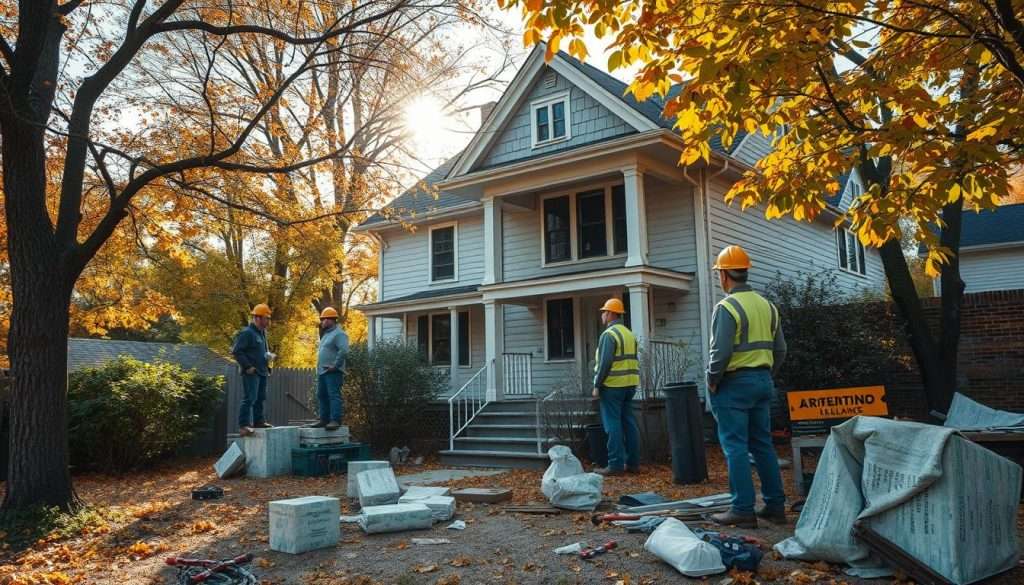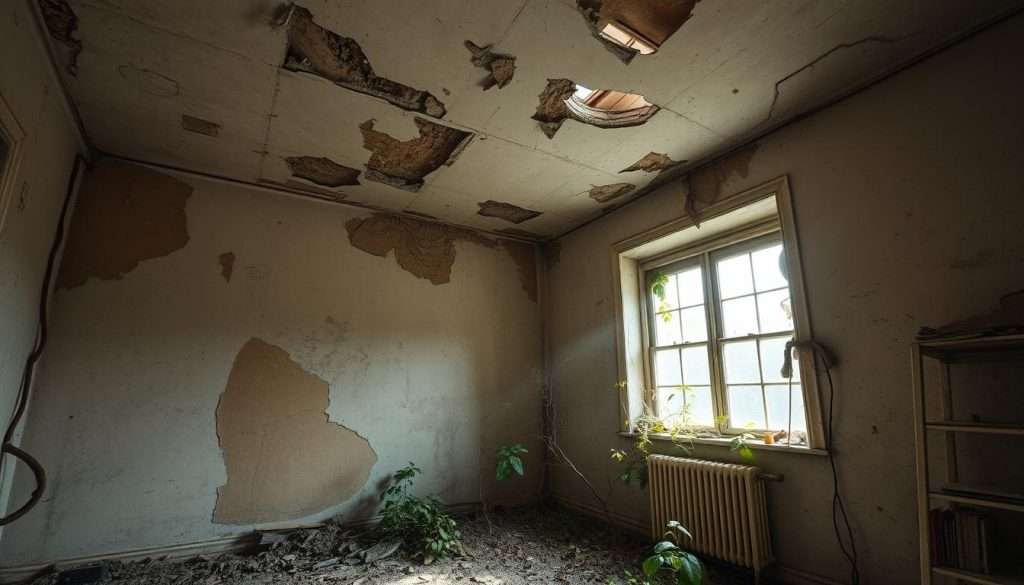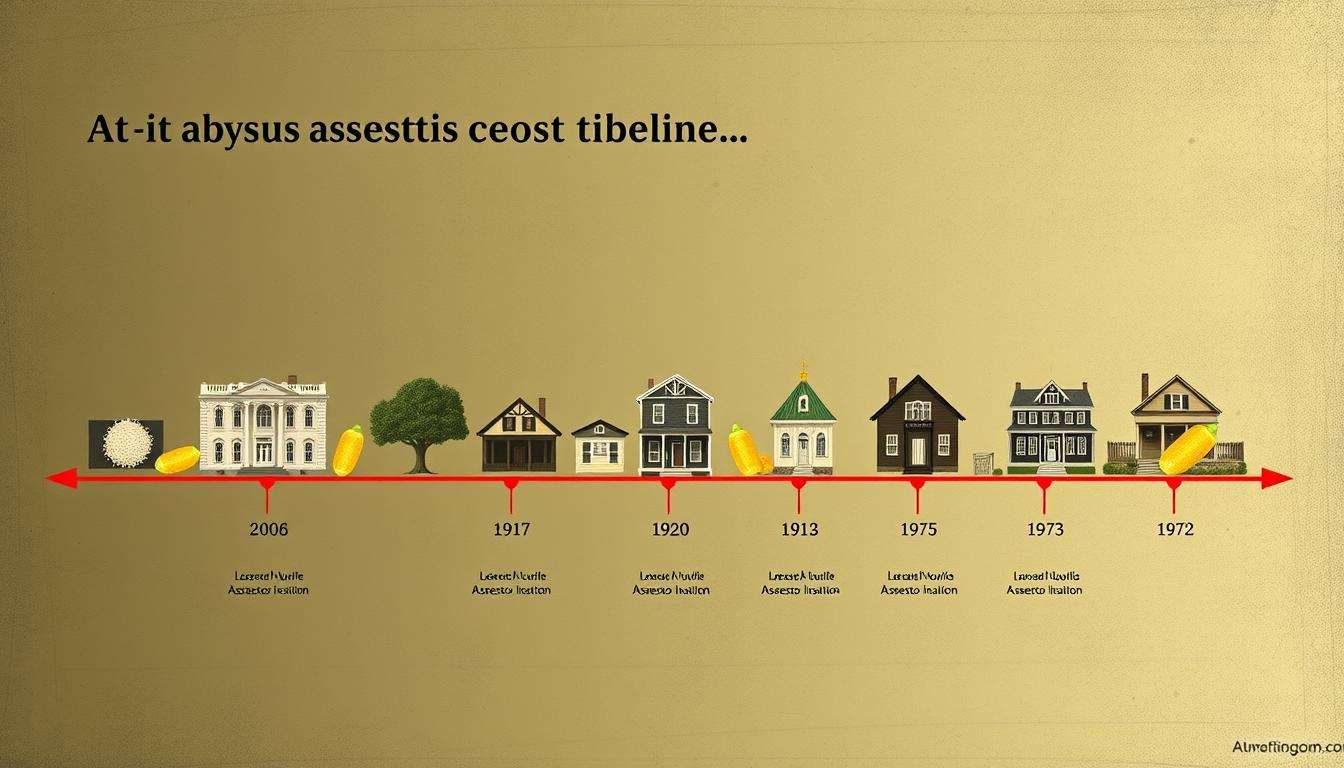Knowing when asbestos insulation was used is key for homeowners and DIY fans. It was used in the U.S. from the 1930s to the late 1970s. Even after that, it was still used in some products until the late 1990s.
This time was a big part of asbestos history. It shows how long asbestos insulation dates go back, starting in the 1920s.
The EPA says the most asbestos was used from 1940 to 1980. Over 30 million tons were used in many materials, like insulation. After World War II, more insulation was made, and worries about asbestos grew.
Even with laws like the Clean Air Act’s bans since 1970, a total ban on asbestos in the U.S. never happened. So, homes built before 1980 might have asbestos. It’s important to get experts to check for asbestos in your home.
In short, the use of asbestos insulation in homes is a big part of building history. It shows both progress and risks. Knowing about it helps keep homes safe.
Key Takeaways
- Asbestos insulation was mainly used in homes from the 1930s to the late 1970s.
- Peak usage was between 1940 and 1980, especially after World War II.
- The EPA said asbestos was dangerous in 1970, starting laws to control it.
- Even with many rules, a total ban on asbestos in the U.S. never happened.
- Homes built before 1980 are more likely to have asbestos.
Overview of Asbestos as an Insulation Material
Asbestos was once a popular choice for insulation. But, people soon learned it was harmful to health. Knowing about its benefits and uses in homes is key for anyone who owns a house or works on buildings.
Properties of Asbestos
Asbestos insulation is known for being heat resistant, strong, and long-lasting. It can handle very high temperatures. It also helps block sound, making it good for keeping noise out.
Benefits of Asbestos Insulation
The good things about asbestos insulation are:
- It’s very good at stopping fires, making buildings safer.
- It helps keep sounds from getting in, making homes quieter.
- It lasts a long time, often for decades without breaking down.
Common Applications in Home Building
Asbestos was used in many ways in homes. It was found in:
- Attics, especially in vermiculite form.
- Around pipes to keep heat in.
- On walls and ceilings to make them fireproof.
Its asbestos insulation properties made it a common choice until the late 1970s. Many old homes still have asbestos, so it’s important to check and manage it carefully.
Historical Timeline of Asbestos Use in Homes
Asbestos has been used in homes for a long time. It started in ancient times. In the United States, its use grew a lot over the years.
This asbestos usage timeline shows how it became popular. Then, its use started to go down.
Early Adoption in the 1900s
In the early 1900s, asbestos became more common in homes. Important events include:
- The introduction of commercial asbestos insulation products in the late 1800s.
- The United States became a big user of asbestos by the early 1900s.
- Production soared, hitting over 30,000 tons a year.
Many asbestos home adoption dates from this time show it was used a lot. It was used for insulation, fireproofing, and more.
Peak Popularity During the 1940s-1970s
Asbestos was at its peak in home building from the 1940s to the 1970s. This was due to:
- High demand for strong and fire-resistant materials.
- It was used in homes for insulation, roofing, and flooring.
- People didn’t know about the health risks of asbestos yet.
Many homes from this time have asbestos. This made it widely accepted.
Decline in Usage in the 1980s
In the 1980s, things changed as health risks became known. Important events include:
- New laws were made, like the EPA’s bans on asbestos products.
- The use of asbestos insulation went down as safer options came along.
- More people got sick from asbestos exposure.
Today, many homes built then still have asbestos. The old ways of building homes still affect how we deal with asbestos now.
Regulations Surrounding Asbestos Insulation
Understanding asbestos insulation rules is key. In the U.S., asbestos laws have changed a lot over time. These rules help keep people safe by controlling how asbestos is used.
Key Legislation Impacting Use
In the 1970s, laws about asbestos started to change the industry. The Clean Air Act of 1970 and the Toxic Substances Control Act (TSCA) of 1976 were big steps. They limited how asbestos could be used.
In 1973, the U.S. stopped using spray-applied asbestos for insulation. By 1975, other uses like pipe insulation were banned too. But, a complete ban on asbestos is still not here, with some uses still allowed.
The Role of the Environmental Protection Agency
The Environmental Protection Agency (EPA) is very important in asbestos rules. The EPA has made rules to stop certain uses of asbestos and teach safe practices. They say that some products can have up to 1% asbestos in certain cases.
The EPA keeps an eye on asbestos to lower risks. This helps keep people safe from asbestos dangers.
Current Standards for Asbestos
Today, we still take a careful approach with asbestos. The U.S. hasn’t banned asbestos completely, but rules are in place to protect us. These rules help tell people about dangers and make sure everyone follows the rules to stay safe.
To learn more about asbestos laws and standards, it’s good to keep up with new information.

Health Risks Associated with Asbestos
Asbestos exposure is very dangerous. It can cause serious health problems. People living in old homes or working with asbestos need to know the risks.
Many get sick from asbestos. This includes diseases that are very hard to treat.
Asbestos-Related Diseases
Asbestos can cause many serious diseases. These include:
- Asbestosis: A lung disease that scars the lungs.
- Lung Cancer: A common disease in people who have been exposed to asbestos, especially if they smoke.
- Malignant Mesothelioma: A rare and aggressive cancer that affects the lungs, belly, or heart.
- Other Cancers: Like laryngeal, ovarian, and colorectal cancers, which can also be caused by asbestos.
Long-Term Effects of Exposure
Even a little asbestos can cause big problems. These problems can take 10 to 40 years to show up. It’s hard to find these diseases early.
Every year, about 10,000 people in the U.S. die from these diseases. This shows how dangerous asbestos is.
Safety Precautions for Handling
It’s very important to be safe when dealing with asbestos. Here are some key steps:
- Avoid touching materials that might have asbestos.
- Get a professional to test and remove asbestos.
- Use contractors who know how to safely remove asbestos.
- Wear protective gear and clothes if you must work with asbestos.
Identifying Asbestos Insulation in Your Home
Checking for asbestos insulation is key to keeping your home safe. This is especially true if your home was built or updated before 1990. Look for asbestos in attics, around pipes, basements, and some ceiling materials. Knowing where to search helps you spot and deal with asbestos risks.
Common Locations for Asbestos Insulation
- Attics, especially where you might find vermiculite insulation.
- Insulation around pipes, which often has asbestos.
- Basements, where insulation was often used.
- Certain ceiling materials, like textured finishes.
Visual Characteristics of Asbestos Products
Knowing what asbestos insulation looks like is important. It usually has a gray, fibrous texture. Vermiculite, for example, looks like pebbles and is grayish-brown to silvery-gold.
Fiberglass insulation is shiny and soft, not fibrous like asbestos. Rock wool insulation is soft and cottony, often gray or white. It’s crucial to know these differences to avoid mistakes.
Importance of Professional Assessment
Spotting asbestos can be hard and not always right. The best way to know if you have asbestos is to get a professional to check. If you find insulation in an old home, call experts right away.
Trained specialists can test and identify asbestos accurately. They make sure your home is safe and follow all asbestos rules.
Alternatives to Asbestos Insulation
Homeowners are looking for safe and effective asbestos alternatives for insulation. They want eco-friendly insulation because of health risks from old materials. New insulation options are safer and make homes more energy-efficient and comfortable.
Popular Eco-Friendly Insulation Materials
Several materials are popular:
- Cellulose: Made from recycled newspaper, it’s fire-resistant. It’s been popular since the 1970s for being cost-effective and good for the environment.
- Fiberglass: It’s fire-resistant and insulates well without the dangers of asbestos.
- Mineral Wool: Made from recycled materials, it’s great for soundproofing and fire-resistance.
- Polyurethane Foam: Introduced in the late 1960s, it insulates and seals air well.
- Natural Materials: Hemp, sheep’s wool, and straw are popular for their sustainability.
Comparison of Performance and Cost
Here’s a comparison of insulation materials by performance and cost:
| Insulation Type | R-Value (thermal resistance) | Cost per Square Foot | Fire Resistance |
|---|---|---|---|
| Cellulose | 3.5-4.0 | $0.70 – $1.00 | High |
| Fiberglass | 2.9-3.7 | $0.40 – $0.90 | Very High |
| Mineral Wool | 3.0-3.3 | $0.80 – $1.20 | Very High |
| Polyurethane Foam | 6.0-7.0 | $1.00 – $2.00 | Moderate |
Benefits of Modern Insulation Options
Modern insulation offers many modern insulation benefits:
- Improved Energy Efficiency: It keeps temperatures steady, saving on energy bills.
- Noise Reduction: Materials like cellulose and mineral wool reduce sound, making homes quieter.
- Health and Safety: These materials are safe, unlike asbestos, making homes healthier.
- Sustainability: Many, like cellulose and mineral wool, use recycled content, reducing environmental harm.
Removal and Abatement Procedures
When you find asbestos in your home, you need to know how to remove it safely. It’s important to know when to call for help, the difference between hiring pros and doing it yourself, and how to stay safe while removing it.
When to Consider Asbestos Removal
Think about removing asbestos if:
- Asbestos materials are damaged or falling apart
- You’re planning to renovate or tear down your home
- You see signs of wear on asbestos products, like crumbling materials
Professional vs. DIY Removal
It’s best to hire experts for asbestos removal. They know how to do it safely to avoid health risks. Trying to do it yourself is not a good idea because it can be very dangerous. Without the right training and tools, you could release harmful fibers into the air.
Safety Measures During Abatement
Keeping everyone safe during asbestos removal is very important. Here are some key steps:
- Wear protective gear, like masks and sealed suits
- Have decontamination units for workers to clean up after handling asbestos
- Seal off the area with plastic to keep fibers inside
- Dispose of asbestos waste at places that are licensed to handle it
By following these safety steps, you can safely deal with asbestos problems. This way, you can protect yourself and others from harm.
| Aspect | Professional Removal | DIY Removal |
|---|---|---|
| Expertise | Trained and experienced personnel | Limited knowledge, high risk of errors |
| Equipment | Advanced tools and safety gear | Basic tools, inadequate for safety |
| Risk Level | Minimized due to procedures | High risk of fiber exposure |
| Cost | Higher initial investment, safer outcome | Lower upfront costs, potential for fines and health issues |
Asbestos Insulation and Home Value
Asbestos insulation can really affect a home’s value. It’s important for buyers and sellers to understand this. Sellers must tell the truth about asbestos to avoid legal trouble.
Impact on Real Estate Transactions
Asbestos makes real estate deals tricky. It’s because of its health risks and history. Homes with asbestos might get lower offers because of removal costs.
Some buyers might not want to buy these homes. Getting a mortgage can also be hard. Lenders might not want to deal with homes that have harmful materials.
Disclosure Requirements for Sellers
Sellers must tell buyers about asbestos in many places. This rule helps avoid lawsuits. Being open about asbestos builds trust.
Homes that are honest about asbestos can still sell well. This is true even with initial worries.
Mitigating Concerns for Buyers
Buyers should get their homes checked for asbestos. Tests cost between $50 and $1,200. This depends on the test type and location.
Buyers can ask for fixes before buying. Getting expert reports can make buyers feel more sure. This is important when investing in a home.
Legacy and Future of Asbestos Insulation
The asbestos legacy in homes is a big deal. It talks about safety and health. As people learn more about asbestos dangers, the U.S. is working to make homes safer. This means moving towards safer, modern insulation.
Remediation Trends in the U.S.
There’s a big push for removing asbestos from homes. States are doing things like:
- Checking older homes for asbestos
- Helping pay for removal
- Making it easier to find professional help
This shows a big effort to keep people safe from asbestos. It also helps follow new rules.
Ongoing Research on Asbestos Effects
There’s a lot of asbestos research going on. Scientists are studying:
- How asbestos affects health
- New ways to find and test asbestos
- Safe, new insulation options
This research could change how we build homes. It could lead to safer materials for the future.
Public Perception and Awareness
More people know about asbestos dangers now. This makes homeowners careful about old homes. They want to know if there’s asbestos.
Over 60 countries banned asbestos. The U.S. is still figuring out its use. Education campaigns are trying to teach people about asbestos risks. They want everyone to know how important inspections are.

Conclusion: Understanding Asbestos in Construction
Knowing about asbestos insulation is key for homeowners and DIY fans. In the 20th century, asbestos was used a lot for insulation and fire safety. But, it can cause serious health problems like lung cancer and mesothelioma.
Rules from the EPA and OSHA remind us to be careful. This is especially true when renovating homes where asbestos might be found.
Summary of Key Points
Asbestos was often in homes, like attics and near heaters. Knowing it’s there can help avoid big risks. Removing asbestos needs special steps to stay safe.
Understanding what asbestos looks like helps make smart choices during home fixes.
Resources for Further Learning
There are many places to learn about asbestos. The EPA has tips for safe home fixes. Local health groups share about asbestos dangers.
Using these resources helps you and others make safer choices. This keeps everyone’s living space safer.
Encouraging Safe Practices in Home Improvement
Putting safety first keeps you and your family healthy. Always follow the right steps when dealing with asbestos. Get help from experts for checks and removals.
By choosing safety and staying informed, you can safely do home repairs and updates.
